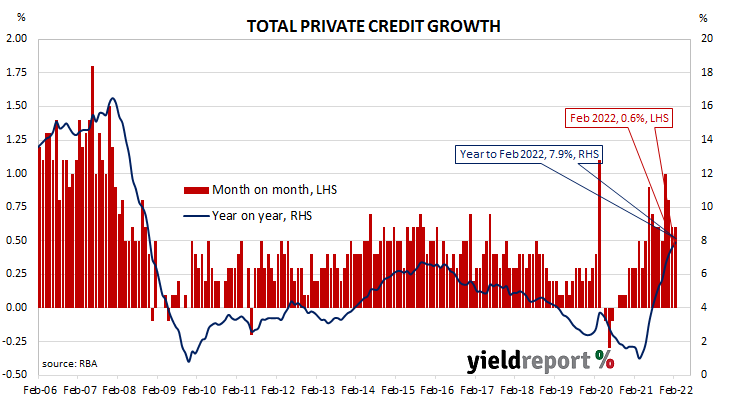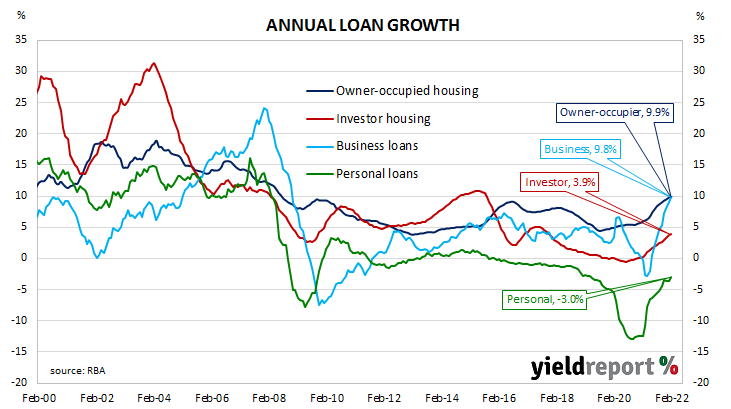Summary: Private sector credit up 0.6% in February; in line with expectations; annual growth rate up from 7.6% to 7.9%; fastest annual pace since November 2008; evidence of confidence in economic outlook, future earnings; business loans account for about 45% of net growth, owner-occupiers loans 40%.
The pace of lending to the non-bank private sector by financial institutions in Australia followed a steady-but-gradual downtrend from late-2015 through to early 2020 before hitting what appears to be a nadir in March 2021. That downtrend ended later in the same year and now annual growth rates are above the peak rate seen in the previous decade.
According to the latest RBA figures, private sector credit growth increased by 0.6% in February. The result was in line with expectations as well as January’s increase. On an annual basis, the growth rate increased from 7.6% to 7.9%.
“Strikingly, credit growth strengthened materially over the past year. Annual growth accelerated from 1.7% at the end of 2020 to be at 7.9% currently. That is the fastest annual pace for credit growth since November 2008, although it is still well below the December 2007 peak of 16.5%,” said ANZ senior economist Andrew Hanlan
Commonwealth Government bond yields declined at the short end but rose farther out along the curve on the day. By the close of business, the 3-year ACGB yield had lost 2bps to 2.56%, the 10-year yield had gained 4bps to 2.90% while the 20-year yield finished 6bps higher at 3.22%.
Expectations of official rate rises over the next fifteen months also softened a little. At the end of the day, contract prices in the cash futures market implied the cash rate would not exceed the RBA’s 0.10% target rate until May but then rise to 0.755% by August. February 2023 contracts implied a cash rate of 1.945%.
“Households and businesses alike are borrowing more, responding to substantial policy stimulus,” Hanlan added. “It is evidence of confidence in the economic outlook and prospects for future earnings. Record low interest rates and generous tax incentives for business investment provided a strong tail wind for the Australian economy.”
Business loans accounted for about 45% of the net growth over the month, while owner-occupier loans and investor loans accounted for a little over 40% and 10% respectively. Total personal debt was unchanged.
The traditional driver of loan growth rates, the owner-occupier segment, grew by 0.7% over the month, slightly lower than January’s 0.8% increase. The sector’s 12-month growth rate accelerated from 9.8% to 9.9%.
Total lending in the business sector also grew by 0.8%, slightly above the long-term monthly average and more than the 0.6% increase recorded in January. The segment’s annual growth rate increased from 9.0% to 9.8%.
Monthly growth in the investor-lending segment slowed to a halt in early 2018. Shortly into the 2019/20 financial year, monthly growth rates slipped into the red before posting a series of flat or near-flat results until mid-2020. In February, net lending grew by 0.4%, the same rate as in January. The 12-month growth rate accelerated from 3.7% to 3.9%.
Total personal loans remained unchanged, up from January’s -0.5%, taking the annual contraction rate from 3.8% to 3.0%. This category of debt includes fixed-term loans for large personal expenditures, credit cards and other revolving credit facilities.



